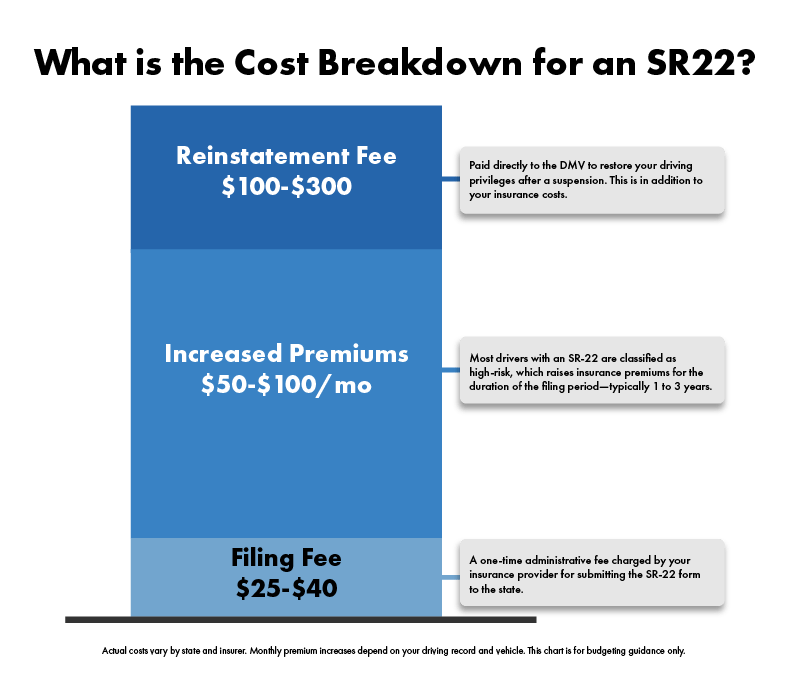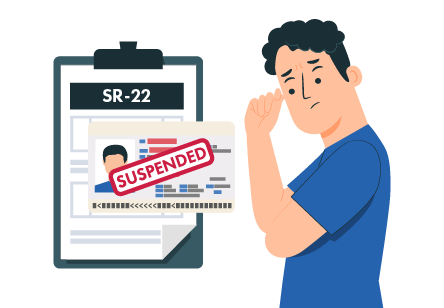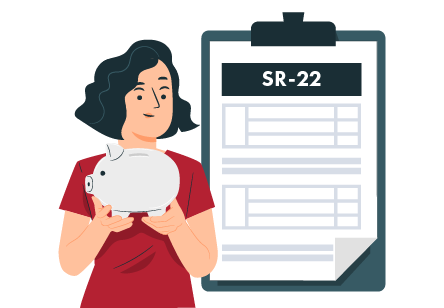Reinstating a suspended drivers license involves meeting several state specific requirements.
A common requirement is to get SR-22 insurance. The requirements vary depending on the traffic offense the driver committed.
To reinstate your driver's license, you may need to file an SR-22 form, pay DMV or court fines, and take a defensive driving or DUI education course.
Working though the SR-22 filing process is necessary to get your driving privileges back and comply with your state's insurance laws.
What is an SR-22?
An SR-22 is proof of financial responsibility that shows you have at least the state minimum liability auto insurance.
An SR-22 certificate is not insurance but a document your insurance company files with the Department of Motor Vehicles to show proof of insurance. The state usually requires this because of a conviction, major traffic ticket, or accident.
Drivers who need an SR-22 certificate are considered high-risk by insurers because they may have been involved in driving offenses like reckless driving, DUIs, or multiple traffic tickets.
Some insurance companies won't even cover drivers who need an SR-22. You'll have to maintain the SR-22 certificate for a state-specified period, so your car insurance doesn't lapse.

The three types of SR-22 certificates are listed below.
Operator's Certificate - Shows you're insured regardless of who owns the vehicle.
Owner's Certificate - Shows a specific car is insured under your name.
Owner-Operator Certificate - Covers you and a specific vehicle.
When the SR-22 form is filed with your insurance company, they will also notify the Department of Motor Vehicles.
Letting your auto insurance coverage lapse will cause more penalties. These include license suspension or more fines.
Understanding the SR-22 process is important for drivers with an SR-22 requirement to get their license back.
Getting an SR-22 form comes with a filing fee and higher insurance costs.
According to an Insurance.com SR-22 Cost Analysis, the one-time filing fee is usually $25 to $40.
The total cost of insurance will be much higher since insurance companies consider you to be at high risk.
In addition to higher premiums, you may also have to pay reinstatement fees for your driver's license or vehicle registration.
According to iDriveSafely, this cost can be anywhere from $20-$650 depending on the state. Most states range between $100 to $300.

Once you have an SR-22 form on file, you must keep continuous insurance coverage.
If your policy lapses or is canceled, your insurance provider must notify the state, and you may get fined, get your SR-22 extended, or even your license suspended. If you drive without insurance, you'll be personally liable for any damages or injuries in an accident.
To avoid penalties and remain compliant, pay your insurance on time and follow all state SR-22 requirements.
How to Reinstate a Suspended License with an SR-22
Reinstate a suspended driver's license by meeting state-mandated requirements, which vary depending on the reason for the suspension.
Typical requirements are to complete the suspension period, pay fines and fees, attend driver safety or DUI programs, and provide proof of financial responsibility (SR-22 insurance).
The steps to complete the application for reinstatement vary by state laws. Make sure to check with your local Department of Motor Vehicles for more information.
The Steps to Reinstate Your Driver's License are listed below.
Step 1. Pay Fines, Court Costs, and Comply with Court Orders
Before applying for reinstatement of your drivers license, you must pay all court-ordered fines and comply with court orders.
These can include paying DMV fines, installing an ignition interlock device, community service, or completing a driver improvement or alcohol education course.
Step 2. Get an SR-22 from your insurance provider
After your fines are paid, you must get an SR-22 or proof of financial responsibility. Not all insurers provide SR-22 forms to high risk drivers, so you may need to shop around for quotes.
You may need non-owner SR-22 insurance to meet the requirement if you don't own a vehicle.
Step 3. Submit the Necessary Documents to the DMV
Your insurer will file the SR-22 form with the state or the DMV. Afterwards you must submit the other required documents to the DMV.
These include proof of insurance, proof of driving course completion, and other necessary documents.
Step 4. Pay the Required Reinstatement Fee
After submitting all documents, pay the reinstatement fees, usually $100 to $300, based on your state rules.
Maintain SR-22 Insurance After Your License Reinstatement
After you get your driver's license back, you must keep SR-22 insurance to comply with the law to avoid another driver's license suspension.
According to the National Highway Traffic Safety Administration (NHTSA) , SR-22 insurance must be carried for 3 years without any lapse in coverage.
If your policy expires or is canceled, your insurance company must notify the DMV. You'll get another suspension and reinstatement fee.
Driving with a suspended license extends the reinstatement process (sometimes up to a year) and has more legal consequences.
To comply, follow state guidelines, ensure continuous coverage, and make timely payments throughout the SR-22 requirement period.
If you don't own a car but are required to carry SR-22 insurance, a non-owner insurance policy will help you meet the requirement.
Reinstating your license through SR-22 insurance is just the first step, good driving behavior is just as important.
Avoid more traffic violations and practice good driving habits. You'll keep your record clean and prevent more penalties.
Following these guidelines can fulfill your SR-22 requirement and keep your license without problems.
Is Driving With a Suspended License a Misdemeanor or a Felony?
Penalties for Driving with a suspended license vary by jurisdiction, offense severity, and prior violations.
A first-time offense is a misdemeanor: fines, probation, or a short jail sentence.
If the suspension is from DUI/DWI, vehicular manslaughter, or reckless driving, or it's a second offense, it can be a felony.
Felony charges carry hefty fines, extended jail or prison time, and a permanent criminal record, which can have long-term effects on employment and personal freedom.
For example in New York, First Degree Aggravated Unlicensed Operation is punishable by up to 2 years in prison.
Depending on the type of suspension, in some states, you may be eligible for a hardship license, which allows limited driving for work, school, medical appointments, or necessary errands.
Contact the DMV or a lawyer to find out if you qualify and how to apply.
Can You Get Arrested for Driving With a Suspended License?
Yes, driving with a suspended license is an arrestable offense. Police can pull you over, arrest you on the spot, and impound your vehicle unless another licensed driver can take custody of the car.
If arrested, remain calm and cooperate with the police. You have the right to remain silent and to speak with a lawyer. Any statements to the police during the arrest can be used against you. Get legal help as soon as possible.
The penalties for driving on a suspended license usually depend on the reason for your drivers license suspension.
Common reasons for a drivers license suspension are listed below.
DUI/DWI convictions
Reckless driving or speeding over 30mph over the limit
Too many traffic violations or points on your license
Failure to appear in court or failure to pay traffic fines
Driving without insurance
Not paying court ordered child support
Hiring a good criminal defense attorney can help. Your penalties can be reduced with earlier possible reinstantement of your drivers license.
How Long Will Your License Be Suspended?
The length of a drivers license suspension depends on the how bad the traffic violation was and your state laws for the violation.
According to the Nolo Driver License Suspensions Guide, for Minor violations, your license can be suspended anywhere for 30 days to several months.
More serious offenses like DUI, repeated traffic violations, or reckless driving, can suspend your license from one year to multiple years.
Different ways a suspended license can affect your daily life are listed below.
Trouble keeping a job due to not being able to drive.
Higher auto insurance rates after your getting your license back.
SR-22 insurance filing in some most cases.
To get your your drivers license back early, it is best to hire a lawyer to see your options.
How to Check if Your License is Suspended
Get an official driving abstract from the DMV to check your driver's license status. This will show if your license is active, suspended, or revoked.
Some other things your a driving record or abstract will show is listed below.
Current traffic violations
Drivers License points
Unpaid fines or court obligations that were not completed.
Many states have online portals to check your license status. All your need is your driver's license number and personal information.
If you need more information, contact the DMV or a lawyer.
What is a Revoked Drivers License?
A revoked drivers license means you permanently lose your drivers license.
A Revoked drivers license is given for serious traffic violations or repeat offenders who negligently break the states driving laws.
There is no easy way to get a revoked license reinstated. You will usually need to hire a lawyer and go through a complex legal process to get your license back.
The Common reasons for license revocation are listed below.
Vehicular manslaughter
Multiple DUI/DWI convictions
Excessive reckless driving or street racing
Failure to comply with drivers license suspension requirements
A medical condition that affects safe driving
Non-compliance with court ordered financial obligations






